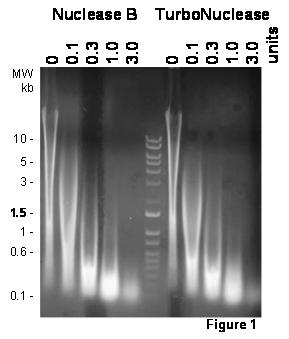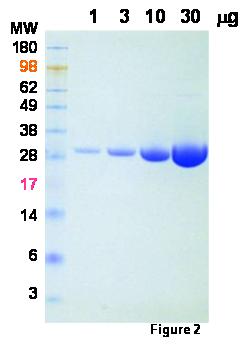TurboNuclease
본문
TurboNuclease(Benzonase equivalent, ultra-pure)
recombinant Serratia macescens extracellular endonuclease (encoded by the same gene of Benzonase)
단백질 조제시 핵산의 제거와 점성의 감소에 이용되는 endonuclease로서, 고순도(99 % 이상)이며 protease free합니다.
제품의 size는 50,000 Units이며(concentration는 250 Units/ul), 저장온도는 -20 ℃입니다. 동일 concentration(250 Units/ul)의
bulk 구매가 가능합니다.
A. Produc detail
1. Description
TurboNuclease is a recombinant form of Serratia macescens extracellular endonuclease (encoded by the same gene of
Bezonase) produced in E. coli using a proprietary process. This nonspecific endonuclease hydrolyzes both single- and
double-stranded nucleic acids (DNA and RNA) to 5’-phosphorylated oligonucleotides of 1-4 bases in length.
TurboNuclease is a highly purified homodimer of 27 kDa subunits that has exceptional high specific activity and is free of
protease activity. TurboNuclease is ideal to digest nucleic acids and to reduce viscosity during protein purification and
sample preparation.
2. Protein type
Endonuclease
3. Source
E. Coli
4. Unit Definition
One unit of TurboNuclease converts 1.0 OD 260 of salmon sperm DNA into acid-soluble nucleotides in 30 minutes at 37oC
in a reaction buffer of 50 mM Tris-HCl, pH 8.0 and 1 mM MgCl2. This corresponds to complete digestion of 50 ug of
salmon sperm DNA into oligonucleotides. TurboNuclease has similar specific activity as Benzonase
5. Endotoxin Level
< 0.1 EU / 1,000 units of TurboNuclease
B. Data sheet
1. Formulation
250 units/ul in 50 mM Tris-HCl, pH 8.0, 50 mM NaCl, 5 mM MgCl2and 50% Glycerol
2. TurboNuclease Activity and Purity

Fig. 1 50 ug of salmon sperm DNA was incubated with the indicated units of TurboNuclease and another brand of
nuclease at 37oC for 30 min in a buffer of 50 mM Tris-HCl, pH 8.0 and 1 mM MgCl2. DNA digestion was monitored by
agarose gel.

Fig. 2 TurboNuclease is purified through a proprietary process that achieves purity of >99%. TurboNuclease has
no detectable protease activity.
C. Protocol
1. Application
TurboNuclease can be used to
- reduce viscosity of cell lysate and reduce back pressure of column loading
- remove nucleic acid contamination from sample preparations, reduce nucleic acid contamination of Ni column
purification
- reduce smearing in SDS-PAGE when used with 10%SDS or Gel Loading Dye to make whole cell lysate
- reduce or prevent clumping of concentrated cells and thawed cells
- replaces crude DNase I in many applications
To reduce viscosity of cell lysate, 10-500 units of TurboNuclease can be used for each gram of cell paste. Generally,
adding TurboNuclease to cell lysate at 25 U/ml is sufficient to reduce lysate viscosity.
The efficiency of viscosity reduction may vary with buffers, cell types, and cell lysis methods used. Due to its high specific
activity, the total amount TurboNuclease added is less than 0.1 ug/ml of lysate and will not complicate any down stream
process.
2. Lare Scale Cell Lysis
a. Make fresh cold Lysis Buffer
Lysis Buffer should be a buffer in which the target protein is soluble.
The Lysis Buffer should be compatible with downstream purification processes, e.g. minimal amount of EDTA or DTT
if Ni column will be used.
Here is an example of Lysis Buffer
25 mM Tris-HCl, pH 8.0
500 mM NaCl
14 mM beta-mercaptoethanol
Detergent can be included for less soluble proteins or when protein solubility is unknown. 1% Triton X-100 has no effect on
TurboNuclease activity.
TurboNuclease has the same activity in 150 mM NaCl or 500 mM NaCl and 400 mM imidazole.
b. Resuspend thawed cell paste in Lysis Buffer
Use 2-10 ml Lysis Buffer for each gram of cell paste. TurboNuclease can reduce the amount of Lysis Buffer used.
We routinely use 2 ml of lysis buffer for each gram of cell pellets.
c. Add TurboNuclease to 25 unit/ml
Protease inhibitors can be added at the same time.
If the lysis buffer contains EDTA or EGTA, add 10-fold more TurboNuclease.
d. Lyze cells by mechanical or chemical methods on ice or at room temperature
TurboNuclease also reduces the viscosity of lysate lyzed by microfluidizer.
e. Clear lysate by centrifugation for column loading
The reduced viscosity makes it possible to clear the lysate at lower speed. 35,000g(~16,000 rpm) for 1 hour is
sufficient.
Lysate can be loaded to "Crude" columns without clearance.
3. Parallel Lysis of Multiple Insect Cell Samples
a. Freeze cells pellets of 5-10 ml culture on dry ice briefly
Freeze and thaw facilitates lysis.
b. Thaw the frozen pellets and completely resuspend in ~1 ml Lysis Buffer with TurboNuclease
c. Transfer the cell suspension to a microtube and sit the tubes on a floater rack
d. Lyze cells using an Ultrasonic Cleaner with ice waterbath for 10 min
Ultrasonic Cleaner (many chemists use it) is much cheaper than probe sonicator. It costs a few hundreds US dollars for
a new model and less than $100 for a used one or a jewelry cleaner from a consumer goods store. Ultrasonic Cleaner is
much better and cheaper than those fancy multi-probe sonicators with the following advantages.
- There is no cross-contamination since each sample is enclosed in a microtube.
- The samples are always cold as long as ice is added in the water-bath.
- There is no limit on the number of samples processed in parallel. A small Ultrasonic Cleaner can easily hold 48 samples
The lysate can be used for analyses of protein expression of whole cell lysate, soluble lysate, or affinity pull-down.
Accelagen Lysis Buffer
25 mM Tris-HCl, pH 8.0
500 mM NaCl
20 mM Imidazole, pH 8.0
14 mM beta-mercaptoethanol
0.5% Triton X-100
25 units/ml TurboNuclease
Ordering information
|
Catalog No. |
Product Name |
Size(Conc.) |
|
N0103M |
TurboNuclease(Benzonase equivalent, ultra-pure) |
50,000units(250 Units/µl) |
|
N0103L |
250,000units(250 Units/µl) | |
|
N0103B |
Bulk |
▣ 관련 페이지 ; Accelagen
댓글목록
등록된 댓글이 없습니다.